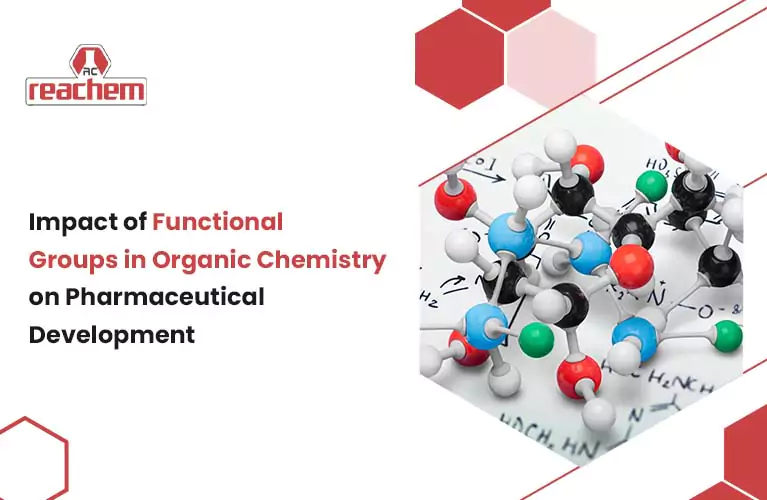wordpress-seo domain was triggered too early. This is usually an indicator for some code in the plugin or theme running too early. Translations should be loaded at the init action or later. Please see Debugging in WordPress for more information. (This message was added in version 6.7.0.) in /var/www/reachemchemicals.com/blog/wp-includes/functions.php on line 6121
Welcome, curious minds, to the fascinating world where chemistry intertwines with pharmaceutical marvels. This blog will discuss the profound impact of functional groups in organic chemistry on developing life-changing drugs. We will also see these molecular entities’ pivotal role in shaping pharmaceutical compounds’ efficacy, safety, and properties. Each functional group holds a unique key to unlocking therapeutic potential, from the humble hydroxyl to the formidable carbonyl. So, join us as we traverse the intricate landscape where chemistry meets medicine, illuminating the path toward groundbreaking pharmaceutical innovations.
Functional groups are the cornerstone of organic chemistry, defining molecules’ chemical properties and reactivity. These groups consist of specific arrangements of atoms within a molecule. Further, they impart distinct chemical characteristics and influence their behaviour in reactions.
Key Points ⟶
Specific atoms or combinations of atoms identify functional groups. These include oxygen, nitrogen, sulphur, or halogens bonded to organic molecules’ carbon backbone.
The vast array of functional groups contributes to the diversity of organic compounds. It ranges from simple alcohols to complex aromatic structures.
Each functional group exhibits unique chemical reactivity, dictating its interactions with other molecules in chemical reactions.
Functional groups contribute to the three-dimensional structure of organic molecules, influencing their physical and biological properties.
Chemical reactions can interconvert one functional group into another, providing synthetic routes for modifying organic molecules.
The role of functional groups is paramount in deciphering their impact on pharmaceutical development. It paves the way for targeted drug design and synthesis.
In pharmaceutical development, the strategic manipulation of functional groups is a fundamental principle in drug design. Medicinal chemists can tailor molecules to achieve desired pharmacological effects. They harness these groups’ distinctive properties while minimising adverse reactions.
Key Points ⟶
Functional groups can enhance the bioactivity of drug molecules. They achieve this by facilitating interactions with target biomolecules, such as enzymes or receptors.
Modifying functional groups can improve the solubility of drug compounds, enhancing their absorption and distribution within the body.
Specific functional groups confer metabolic stability to drug molecules, prolonging their half-life and ensuring sustained therapeutic effects.
Functional groups can confer targeting specificity to drug molecules. They do this by directing them to specific tissues or cellular receptors for enhanced therapeutic efficacy.
Functional groups can be strategically incorporated into prodrugs to improve their pharmacokinetic properties—for example, enhanced absorption or prolonged release.
The strategic incorporation of functional groups in drug design holds immense promise. It allows for the development of safer, more effective pharmaceutical agents. This is heralding a new era of precision medicine.
Pharmacokinetic and pharmacodynamic processes govern the journey of a drug molecule from administration to therapeutic action. Here, functional groups play a pivotal role in shaping its fate within the body.
Key Points ⟶
Functional groups influence the absorption of drugs across biological membranes. Hydrophilic groups enhance water solubility, while hydrophobic groups facilitate passive diffusion.
The presence of specific functional groups can alter the distribution of drugs within bodily tissues. This alteration affects their concentration profiles and, consequently, their therapeutic efficacy.
Functional groups serve as substrates for metabolic enzymes. They influence the biotransformation and elimination of drug molecules from the body.
Functional groups can influence the binding affinity of drugs to plasma proteins. This influence affects their distribution and availability at target sites.
Specific functional groups can enhance the renal excretion of drugs. They facilitate the elimination of drugs from the body, thus preventing potential toxicity.
Researchers can optimise drug formulations to achieve desired therapeutic outcomes. They do this by understanding the interplay between functional groups and pharmacokinetic/pharmacodynamic processes. This helps in minimising adverse effects.
To illustrate the profound impact of functional groups on pharmaceutical development, delve into captivating case studies. These highlight their role in the synthesis and optimization of therapeutic agents.
Key Points:
The acetyl functional group in aspirin enhances its analgesic and anti-inflammatory properties. At the same time, it mitigates gastric irritation. This exemplifies the strategic incorporation of functional groups for improved drug safety and efficacy.
A secondary amine functional group in propranolol confers beta-adrenergic blocking activity. This renders it effective in the management of hypertension and cardiac arrhythmias.
Fluoxetine, renowned for its antidepressant effects, features a trifluoromethyl functional group. This enhances its selectivity for serotonin reuptake inhibition, underscoring the role of functional groups in modulating drug specificity and potency.
The carboxylic acid functional group in ibuprofen is crucial for its anti-inflammatory and analgesic properties. This contributes to its widespread use in pain management.
The phenolic hydroxyl group in morphine plays a crucial role in its analgesic activity. It facilitates interactions with opioid receptors in the central nervous system. This highlights the importance of functional groups in drug-receptor interactions.
Through these illuminating case studies, we witness firsthand how functional groups serve as the building blocks of pharmaceutical innovation. It shapes the landscape of modern medicine and improves the quality of life for countless individuals.
The impact of functional groups in organic chemistry on pharmaceutical development is nothing short of transformative. These molecular entities wield immense influence, from drug design and optimization to pharmacokinetics and therapeutic efficacy. They guide pharmaceutical science’s evolution towards unprecedented precision and effectiveness. As we continue to unravel the mysteries of molecular design, cherish the boundless possibilities that lie ahead. It is fueled by the ingenuity of human creativity and the enduring power of chemistry to heal and inspire. Together, we embark on a journey toward a brighter, healthier future where the promise of tomorrow’s medicines shines ever more colourful.